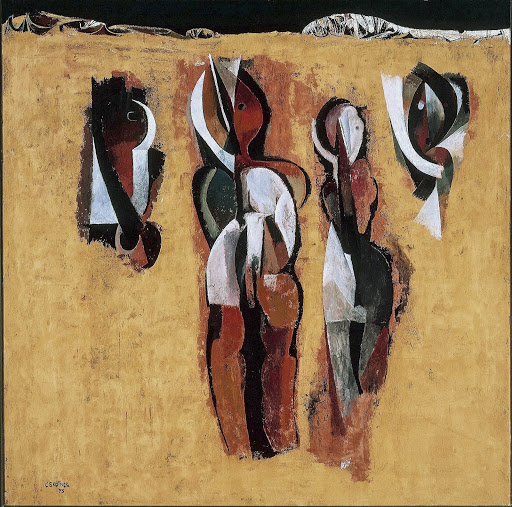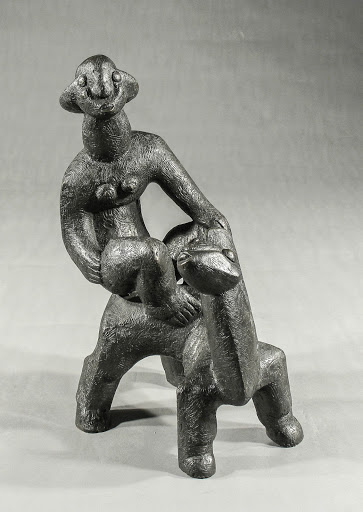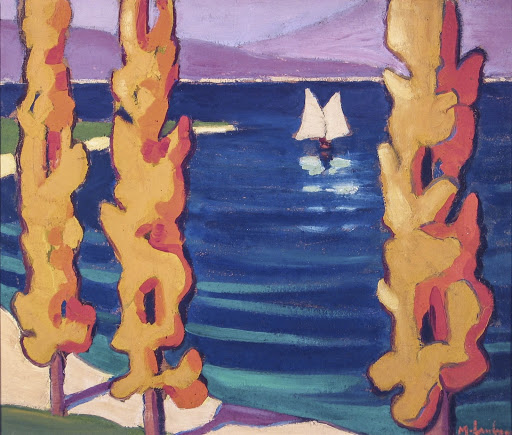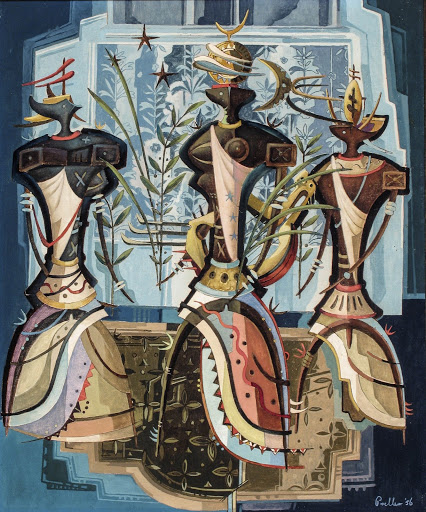Gerard Sekoto, Indaba, c. 1942, oil on canvas. (Sanlam Art Collection)
The fine-arts industry, with its mixed bag of posterity and austerity, has not been immune to the spread of Covid-19. Artists, art collecting, auctions, galleries, and museums have been so severely affected that things might never go back to how they once were.
Consuming art is a visual activity that uses sight and sometimes touch at galleries, museums, or even private showings. But almost a year since the outbreak, the persistent Covid-19 has been making purveyors of art realise that many people are happy to appreciate or buy art online.
Increasingly, people are enjoying the comfort and safety of their homes and using their computers to browse and bid on artworks valued at a few thousand to a few million rands.
There are disadvantages to such online commerce. For one, many artworks fail to sell successfully online. It is mostly artworks at the top end of the market, representing well-established artists, with perceived unique value, that sell consistently and even achieve record prices. For example, works by Irma Stern, a South African artist who achieved national and international recognition in her lifetime, have a following and admirers with a good idea of their aesthetic quality and value. The same goes for Gerard Sekoto, Maggie Laubser and Sydney Kumalo.
But if, for example, the art is a debut piece by Joe Soap from Cape Town, it is unlikely to sell.
Interestingly, the art that has not sold well online is by old, pale male artists from over 60 years ago, or those who have died. There are exceptions, such as Alexis Preller, Erik Laubscher and Cecil Skotnes. The works of renowned artist William Kentridge remain topical and successful.
 Cecil Skotnes Visit to a Battle Field, 1975, oil on canvas on board. (Sanlam Art Collection)
Cecil Skotnes Visit to a Battle Field, 1975, oil on canvas on board. (Sanlam Art Collection)
Auctions
On the auction front, Covid-19 has forced this platform to go digital too. While this translates into some cost savings on gallery space for live auctions, the savings are spent elsewhere, mostly on technology.
It is not yet clear whether online art auctions are a success or not. What is certain is that the galleries have experienced losses in revenue and foot traffic. Those that have gone online have survived but the smaller galleries have had to close.
An obvious impact of the pandemic on museums worldwide, especially in the United States and Britain, is that people have stopped visiting them. As a result, several museums in the US have decided to sell some of their valuable pieces on auction. Previously this was deemed unethical and unacceptable. The caveat is that the funds go toward keeping the museums operational.
As the pandemic persists, what we may see over the next few months is lots of museum-class art from the US and Europe entering the global art market. Whether this would be good for the market depends on the quality and desirability of the artwork on offer. Just because it comes from a museum doesn’t necessarily mean it’s good. Whether it’s desirable is entirely a different story.
 Sydney Kumalo, Horse and Rider, c. 1964, bronze. (Sanlam Art Collection)
Sydney Kumalo, Horse and Rider, c. 1964, bronze. (Sanlam Art Collection)
The Black Lives Matter (BLM) movement has created an additional shift in dynamics. In the visual arts environment, there have been heated debates about the historical role of black artists in the US, Europe and here, too. So what is to happen to the art of all those dead and buried pale males whose art still commands the spotlight? Will their art be allowed to remain in the public eye, or should it be snubbed? This is part of the ongoing debate raging in the arts world.
BLM has shifted the focus of the art media, critics and collectors to the neglect by art-collecting institutions of the art produced by people of colour and in historically and intellectually marginalised communities. This shift has provided opportunities for nimble agents to cash in quickly by resurrecting and foregrounding previously ignored artists of colour.
Galleries showing at major art fairs, live or virtual, over the last year have quickly augmented their offerings or even compiled exhibitions exclusively devoted to such artists. To what extent artists of colour will benefit in the long term is not certain, but where institutions have shifted focus, such changes usually persist.
Commercially, it means a greater diversity of options for collectors, which will develop a greater diversity of works on display in museums and collections in time to come. Does this mean that the white celebrity artists of the past are going to recede? To some degree, that has been happening for years already. However, it is clear that quality work, irrespective of the ethnicity of the producer, seems to survive even the most turbulent of changes.
 Maggie Laubser, Poplars – Italy, 1922, oil on board. (Sanlam Art Collection)
Maggie Laubser, Poplars – Italy, 1922, oil on board. (Sanlam Art Collection)
Even the major international art fairs such as Art Basel have exited the physical space and gone digital. They have done well with online sales. Art Basel is a for-profit, privately owned and managed international art fair staged annually in Basel, Switzerland; Miami Beach, Florida; and Hong Kong.
Losses
The economically beneficial knock-on effects of physical events, however, have been lost. Considering Art Basel usually runs for 10 days, the first five days attract the richest 2 500 to 3 000 people in the world interested in buying art. They also stay in luxury accommodation and spend on other luxuries during their stay. This has a substantial positive effect on the economy. With exhibitions going digital, that economic benefit is just gone.
The same applies to the Cape Town Art Fair, which has become a well-established institution in Africa. While we now know that we might be having the Cape Town Art Fair from 21 to 23 May 2021, and the Joburg Art Fair is no longer a physical event. Therefore, the economic spend from many visitors no longer benefits the local economy.
The net effect of such developments is that there will be an overall decline in terms of the arts contribution to the global economy. If you look at the auctions in South Africa that publish their sales, they handle a reported R300-million plus in annual turnover of fine art. Including galleries, the art circulating in these spaces is worth approximately R1-billion to R2-billion annually.
The art market is adapting quickly and successfully to the digitally driven economy. Although the total value of sales over the past 10 to 12 months may be down, there has been exceptional growth in new participants — buyers, sellers and market-watchers. All the signs are there that the art market will recover and grow with the help of digital technology as it makes the transaction process more comfortable.
 Alexis Preller, Prima Vera, 1956, oil on canvas on board. (Sanlam Art Collection)
Alexis Preller, Prima Vera, 1956, oil on canvas on board. (Sanlam Art Collection)
Where previously the live auction was a stage for the super-rich, now you have anonymous participants from all over the world, participants who may not want to be seen. The auction room has just grown to global dimensions.
This doesn’t mean that the spectacle of gavel, paddle and Gucci-apparelled crowds applauding record prices has gone away. It’s been around for centuries and, given human nature, will be around in some form for quite some time to come.
Stefan Hundt is the curator of the Sanlam Art Collection. For more on the collection, visit blog.sanlam.co.za/artcollection/about/